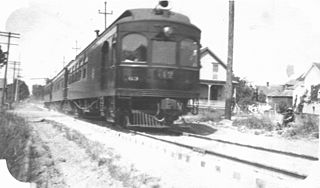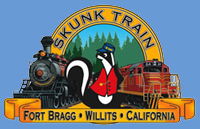
The Oregon Electric Railway (OE) was an interurban railroad line in the U.S. state of Oregon that linked Portland to Eugene.

The Virginia and Truckee Railroad is a privately owned heritage railroad, headquartered in Virginia City, Nevada. Its private and publicly owned route is 14 miles (23 km) long. When first constructed in the 19th century, it was a commercial freight railroad which was originally built to serve the Comstock Lode mining communities of northwestern Nevada.

The California Western Railroad, AKA Mendocino Railway, popularly called the Skunk Train, is a rail freight and heritage railroad transport railway in Mendocino County, California, United States, running from the railroad's headquarters in the coastal town of Fort Bragg to the interchange with the Northwestern Pacific Railroad at Willits.

The Nevada Northern Railway was a railroad in the U.S. state of Nevada, built primarily to reach a major copper producing area in White Pine County, Nevada. The railway, constructed in 1905–06, extended northward about 140 miles (230 km) from Ely to connections with the Western Pacific Railroad at Shafter and Southern Pacific Railroad at Cobre. In 1967 NN reported 40 million net ton-miles of revenue freight on 162 miles (261 km) of line.

The Missouri & Northern Arkansas Railroad, LLC is a Class II Regional Railroad in the U.S. states of Missouri, Kansas, and Arkansas. The company is headquartered in Carthage, Missouri. It is not to be confused with the Missouri and North Arkansas Railroad which connected Joplin, Missouri, with Helena, Arkansas, from 1906 to 1946.

The Sierra Railroad Corporation is a privately owned common carrier. Its Sierra Northern Railway freight division handles all freight operations for all branches owned by the Sierra Railroad. The company's Mendocino Railway group operates the diesel- and steam-powered Sacramento RiverTrain (Woodland-Sacramento) and the Skunk Train. The company's Sierra Energy division is for energy projects.

The California Northern Railroad is one of several Class III short-line railroad companies owned by Genesee & Wyoming, Inc. It operates over Southern Pacific Railroad (SP) tracks under a long-term lease.

The Northwestern Pacific Railroad is a 271-mile (436 km) mainline railroad from the ferry connections in Sausalito, California north to Eureka with a connection to the national railroad system at Schellville. The railroad has gone through a history of different ownership and operators but has maintained a generic name of reference as The Northwestern Pacific Railroad, despite no longer being officially named that. Currently, only a 62-mile (100 km) stretch of mainline from Larkspur to the Sonoma County Airport in Windsor and east to Schellville on the “south end” is operated by Sonoma–Marin Area Rail Transit (SMART), which operates both commuter and freight trains with plans for future extension north to Cloverdale. The “north end” from Willits to Eureka is currently out of service, but saved by 2018 legislation to be converted into the Great Redwood Trail.
The Eagle Salt Works Railroad was a 13.5 mile shortline railroad that ran northeast from a connection with the Southern Pacific Company at Luva to Leete, Nevada. The line then branched from the old Central Pacific grade and went southeast for about 2 miles to the Eagle Salt Works.

The McCloud Railway was a class III railroad operated around Mount Shasta, California. It began operations on July 1, 1992, when it took over operations from the McCloud River Railroad. The MCR was incorporated on April 21, 1992.

The Albany and Eastern Railroad is a short line railroad in the Willamette Valley of Oregon that was created when the BNSF Railway spun off its Sweet Home Branch Line in May 1998. It operates about 64 miles (103 km) of track and is based in Lebanon, Oregon. The main line runs from Albany to Lebanon, with two branch lines at Lebanon going to Sweet Home and Mill City. At the Albany end of the main line it connects to Union Pacific and BNSF lines.
The Butte County Railroad was a 31.5-mile (50.7 km) class II railroad that ran from a connection with the Southern Pacific Railroad at Chico, California to the Diamond Match Company lumber mill at Stirling City. The railroad operated from 1903–1915 and then became the Southern Pacific's Stirling City Branch. From 1915 until abandonment in the 1970s the line was operated as the Southern Pacific's Stirling City Branch. The Chico and Northern Railroad was a non-operating subsidiary holding company of the Southern Pacific Railroad that was created to acquire a 32.31 mile line from Chico – Stirling City from the Butte County Railroad. Upon acquiring the line, Chico & Northern immediately leased the line back to the Butte County Railroad. The Chico & Northern was dissolved into Southern Pacific in 1912 and never operated any of the line.
The San Joaquin and Sierra Nevada Railroad was originally built as a 3 ft narrow gauge that ran from Bracks Landing to Woodbridge and Lodi and then east to the Sierra Nevada foothill town of Valley Springs. The railroad was incorporated on March 28, 1882 and construction was completed on April 15, 1885. The railroad was built as a common carrier with copper mining being its primary traffic. The track was built using 35/40 lb steel rails.
The Vaca Valley and Clear Lake Railroad was a standard gauge railroad that operated at Vacaville, California in the late 19th century. The Vaca Valley Railroad was incorporated on April 12, 1869 to run a branch from the mainline of the California Pacific Railroad at Elmira to Rumsey.

The Amador Central Railroad was a standard gauge railroad that operated 11.8 miles (19.0 km) between a connection with the Southern Pacific Company (SP) at Ione and Martell near the town of Jackson, California. The carrier served the Sierra Nevada Foothills gold mining communities and hauled lumber products from the El Dorado National Forest. Amador is the name of the county in which the railroad operated.
The Northern Railway was a non-operating subsidiary of the Southern Pacific Railroad during the 19th century, created primarily as a device to consolidate the management of a number of smaller subsidiary railroads. The initial railroad opened in 1876 from Woodland, California, to Williams; and extended to Willows in 1878, and to Tehama in 1882. In 1877, a line of the Northern Railway was built between Oakland and Martinez. By the time of its 1898 merger into Southern Pacific, it also controlled the Winters and Ukiah Railway, the Woodland, Capay and Clear Lake Railroad, the West Side and Mendocino Railroad, the Vaca Valley and Clear Lake Railroad, the San Joaquin and Sierra Nevada Railroad, the Sacramento and Placerville Railroad, the Shingle Springs and Placerville Railroad, the Santa Rosa and Carquinez Railroad, the Amador Branch Railroad, and the Berkeley Branch Railroad.

Fruto is an unincorporated community in Glenn County, California. It is located 14 miles (23 km) west-northwest of Willows, at an elevation of 610 feet. It is located along State Route 162. Fruto was established in 1888 as the terminus of the Westside and Mendocino Railroad company and was a shipping point for fruit and wool grown in the area.

The Minarets and Western Railway was a Class II common carrier that operated in Fresno County, California, from 1921 to 1933. The railway was owned by the Sugar Pine Lumber Company and was built the same year the lumber company was incorporated so that it could haul timber from the forest near Minarets to its sawmill at Pinedale. The southern portion of the line was operated with joint trackage rights with Southern Pacific.
This article lists the railroads and a timeline of railroad history in Solano County, California.

The Fort Bragg and Southeastern Railroad was formed by Atchison, Topeka and Santa Fe Railway as a consolidation of logging railways extending inland from Albion, California on the coast of Mendocino County. The railroad and its predecessors operated from August 1, 1885 to January 16, 1930. The line was merged into the regional Northwestern Pacific Railroad in 1907; but planned physical connection was never completed.














